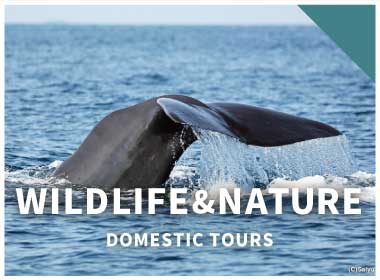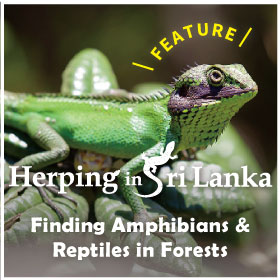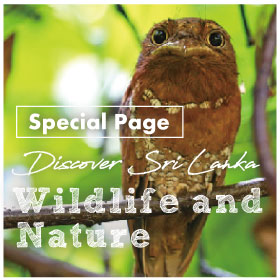- TOP
- 「Herping in Sri Lanka」

- Tours
- Tours>
- Features

Black cheeked lizard

Termite hill gecko

Barne's cat snake

Sri Lankan Land Monitor

Anthropogenic Shrub Frog

Herping in Sri Lanka

What is herping? The word “Herping” comes from herpetology, which is the study of reptiles and amphibians. So “herping” is an activity to search for and observe these reptiles and amphibians. Looking for small creatures in the wild, reminds us to observe and appreciate mother nature’s creativity. These tiny life forms are so unique and adapted to their habitat with beautiful shapes and colors.
The island of Sri Lanka is located just south of the Indian Peninsula in the Indian Ocean, and it has an area of 65,610 sq. km. When we consider the number of endemic species and subspecies that exist in Sri Lanka, it is blessed to be so small and yet, have such a rich diversity. There are vast plains in the north, which have a hot, dry climate; but in the central highlands with peaks of up to 2,000m high, the climate is totally different. And the landscape is transformed throughout the year by the monsoon season. These differences are extreme and are precisely the reason why an incredibly rich diversity of wildlife can be found on an single island. Especially considering that herps don’t have the capacity to travel over long distances, the fact that there are about 115 endemic species of reptiles, and 112 endemic species of amphibians is incredible. This is why we herp in Sri Lanka, a treasure trove of endemic species.
Where to find them?

When we talk about the landscape of the Island, we divide it into 4 climate zones: 1. Dry-low land zone; 2. Wet-low land zone; 3. Wet-middle land zone; 4. High land zone. Each climate zone has its own set of unique reptiles and amphibians, adapted to thrive in that particular environment. For example, each species may have a different time of day they are active, some in the morning and some only at night, having a temporal niche, which provides us with opportunities to see so many different species in a small area. That is why we go to herp from very early morning to late at night, depending on the target species; to maximize our opportunities to fulfill all the herping goals for the entire group. Now we will introduce you to each area and the species we hope to see there.
Herping spot #01Wilpattu
This place is famous as the largest national park in Sri Lanka. But until recently, it was hard to visit there due to a civil war. It was the difficulty of entering the area which kept the natural area untouched and pristine, including the habitats of the reptiles and amphibians. Herping in a dry zone is not easy because they are hiding in high humidity places like under the driftwood, but the effort is well worth it when you finally have the chance to see the amazingly beautiful creatures.

Forest of Wilpattu

Sri Lanka land monitor

Termite hill Gecko

Indian Star Tortoise

"Uperodon scaber"
Herping spot #02Knuckles Mountain Range
The name of this area comes from the shape of the 5 highest peaks which looks like a human knuckles. The altitude is around 1400m and the rainfall and the humidity is incredibly high. There are so many endemic species named ‘Knuckles’ after the region, since they can only be found here. There are the famous Knuckles pygmy lizard, Pethiyagoda’s crestless lizard, Leaf-nosed lizard and many other rare species here.

Knuckles mountain range

Leaf-nosed Lizard

Knuckles Shrub Frog

Knuckles Pygmy Lizard

"Calotes manamendrai"
Herping spot #03Kitulgala
This wet-low land zone is famous for its extremely high heat and humidity. The herps are very active in this area so it is easier to spot them. The Hump-nosed lizard, Kangaroo lizard and so many other iconic species live here. Many river activities are also popular here like rafting and seeing the waterfalls. While the people enjoy the river, there are Sri Lankan rock frogs watching them from the rocky river side.

Kitulgala

Meet Golden back frog under the leaf

Kangaroo Lizard

Hump-Nosed Lizard

Three-Toed Snake Skink
Herping spot #04Horton Plains
This is the highest area (1,800m〜2,300m) of Sri Lanka. The Rhino horn lizard, Black cheeked lizard and Sri Lanka bug-eyed frog live in this area. They are considered one of the most important genetically because we cannot see them anywhere else in this world. These species were isolated here by the other climate zones so they could highly specialize in these high elevations.

Black-cheek lizard

Horton Plains
Sri Lanka
Herping GuideEndemic subspeciesSri Lankan Land Monitor Varanus bengalensis lankae150cm
Varanus bengalensis lankae150cmThese monitor lizards were classified as the “Bengal monitor” until recently, but because of differences in the skull shape and other distinctions, they were identified as a new sub-species. This lizard possesses a Jacobson's organ, which it uses to detect prey from a long distance. It can track the smell of prey by sticking its forked tongue out to gather small scent particles, and then touching it to the opening of the organ when the tongue is retracted.
Termite Hill Gecko Hemidactylus riedrus14cm
Hemidactylus riedrus14cmThis gecko has brilliant white dots on its back. It was often seen looking for food around termite mounds, so that became its name. A distinct feature of this nocturnal gecko is its large eyes; large pupils and a lack of eyelids . They live in semi-arid zones of Sri Lanka and South India.
Endemic speciesKandy Day Gecko Cnemaspis kallima47mm
Cnemaspis kallima47mmThis endemic species lives around the knuckles range. Most of the geckos are nocturnal but this one is diurnal and sleeps at night. They also don’t have eyelids, like the nocturnal geckos, but their eyes are relatively smaller. They have a 6-7 V-shaped patterns on their back.
"Uperodon scaber" Uperodon scaber55mm
Uperodon scaber55mmA very rare species that is not listed in field guides. They spend most of their time deep in the soil to avoid drying out and only come up to the surface during the monsoon season. To keep their surface area as small as possible, they are spherical, like a ball. This little frog was trying to intimidate us by inflating its body with air, when we found him.
Endemic speciesLeaf-nosed Lizard Ceratophra tennentii25cm
Ceratophra tennentii25cmAn agamid lizard which has a leaf-shaped snout, they are born with. Males have a larger “leaf” and the bigger it is, the more females they can attract. They can only be found between the altitudes 700m to 1,700m in Sri Lanka in very wet areas. Feeds mainly on bugs and ants but they might feed on smaller lizards of the same species too.
Endemic species"Calotes manamendrai" Calotes manamendrai
Calotes manamendraiThis is another species that is agamid and not listed on the field guides. It is quite rare among terrestrial animals to have blue coloring, but this blue-striped agamid lizard has this color only when it is sleeping. When it is active, the color changes to green and black. They are often found sleeping on small branches, it is believed this is so that they will know when a predator comes near.
Flowery Wolf Snake Lycodon anamallensis40cm
Lycodon anamallensis40cmThe head is flat, pear shaped with smooth scales and small. It distinctly has spots that resemble small flowers decorating its scales. Nocturnal, they feed on geckos and skinks. When disturbed, hides its head underneath the coils of its body. They are found in the dry low land areas of Sri Lanka and South India.
Endemic speciesKnuckles Shrub Frog Pseudophilautus fulvus47mm
Pseudophilautus fulvus47mmThis frog is endemic to knuckles mountain range, around altitudes 450m-1,200m. They live only in a small area, but it is not difficult to see them, as they are thriving in their habitat. . We can see orange, grey and brown morphs all in one place. They have distinct features like smooth hind legs and feet and a sharp ridge along their head and snout.
Green Vine Snake Ahaetulla nasuta120cm
Ahaetulla nasuta120cmNormally snakes do not have the best eyesight, but these snakes like to feed on lizards by using their good binocular vision to hunt. They have a long slender nose that allows both its eyes to see straight on. Snakes usually depend on their senses like heat and smell by their tongues to look for food, so this adaption of good vision is a special genetic trait. It is very difficult to spot this snake in the wild, because of the long slender, body which blends in so well with its surroundings.
Endemic speciesKangaroo Lizard Otocryptis weigmanni25cm
Otocryptis weigmanni25cmTheir hindlegs are four times longer than its forelegs, making it possible for them to jump like a kangaroo. Matured males have a big yellow and red colored dewlap to attract females and to signal their territory to other males. Depending on the region, there are areas that have a blue-faced morph.
Endemic speciesBarne's Cat Snake Boiga barnesii60cm
Boiga barnesii60cmThe large cat-like eyes on this relatively small-bodied snake is their namesake. Normally feeds on geckoes and skinks, they use their mild venom to kill the prey, so as not to hurt themselves or risk getting attacked. Their very wavy body and huge, cute eyes make them very iconic and memorable.
Indian Star Tortoise Geochelone elegans40cm
Geochelone elegans40cmThese are well-known as one of the most beautiful tortoises in the world with the iconic star patterns on the shell. Their habitat is widespread from South Asia but the population in Sri Lanka is famous for having a more yellowish color and it is considered more beautiful. Highly marketed in the pet trade, these tortoises are listed on the CITES Appendix I, given the highest protection levels. Unfortunately, their numbers declining and it is famously rarer to find them in the wild.
Endemic speciesHump-Nosed Lizard Lyriocephalus scutatus35cm
Lyriocephalus scutatus35cmEasily distinguished from the other agamid lizards because of the knob-like appendage on the end of its snout. They live in the wet-low land zone in Sri Lanka, spending most of their time clinging to thicker tree trunks in the jungle. This lizard branched off the genetic tree early, compared to all the other agamid species so it has many distinct features that make it very famous among many herping enthusiasts.
Endemic speciesThree-Toed Snake Skink Nessia burtonii12cm
Nessia burtonii12cmAt a glance, it looks like a snake. But as a skink, it has 4 tiny legs, each which have 3 toes; eyelids and very fine scales on its belly. However, the ears are not visible like in other lizards, since they live among loose soil or in the leaf litter, the ears are covered with their skin. They mainly feed on termites and earthworms.
Endemic speciesBlack-Cheek Lizard Calotes nigrilabris45cm
Calotes nigrilabris45cmAn endemic lizard to The Horton Plain mountain areas of elevation 1,400m and above in Sri Lanka. While matured males have larger black cheeks, the females and immature young have green cheeks. Due to the elevation, the temperature drops at night time, so when they bask in the morning sun first thing, they can change their body color to all black to maximize the opportunity to heat up their body.













